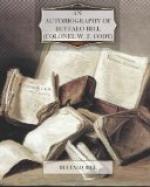Darkness came, and I still toiled along. The men ahead were almost out of hearing. Presently the moon rose, dead ahead of me. And painted boldly across its face was the black figure of an Indian. There could be no mistaking him for a white man. He wore the war-bonnet of the Sioux, and at his shoulder was a rifle, pointed at someone in the bottom below him. I knew well enough that in another second he would drop one of my friends. So I raised my Yaeger and fired. I saw the figure collapse, and heard it come tumbling thirty feet down the bank, landing with a splash in the water.
McCarthy and the rest of the party, hearing the shot, came back in a hurry.
“What is it?” asked McCarthy, when he came up to me.
“I don’t know,” I said. “Whatever it is, it is down there in the water.”
McCarthy ran over to the brave. “Hi!” he cried. “Little Billy’s killed an Indian all by himself!”
Not caring to meet any of this gentleman’s friends we pushed on still faster toward Fort Kearney, which we reached about daylight. We were given food and sent to bed, while the soldiers set out to look for our slain comrades and to try to recover our cattle.
Soldiers from Fort Leavenworth found the herders, killed and mutilated in the Indian fashion. But the cattle had been stampeded among the buffalo and it was impossible to recover a single head.
We were taken back to Leavenworth on one of the returning freight wagon-trains. The news of my exploit was noised about and made me the envy of all the boys of the neighborhood. The Leavenworth Times, published by D.B. Anthony, sent a reporter to get the story of the adventure, and in it my name was printed for the first time as the youngest Indian slayer of the Plains.
I was persuaded now that I was destined to lead a life on the Plains. The two months that our ill-fated expedition had consumed had not discouraged me. Once more I applied to Mr. Majors for a job.
“You seem to have a reputation as a frontiersman, Billy,” he said; “I guess I’ll have to give yon another chance.” He turned me over to Lew Simpson, who was boss of a twenty-five wagon-train just starting with supplies for General Albert Sidney Johnston’s army, which was then on its way to Great Salt Lake to fight the Mormons, whose Destroying Angels, or Danites, were engaged in many outrages on Gentile immigrants.
Simpson appeared to be glad to have me. “We need Indian fighters, Billy,” he told me, and giving me a mule to ride assigned me to a job as cavayard driver.
Our long train, twenty-five wagons in a line, each with its six yoke of oxen, rolled slowly out of Leavenworth over the western trail. Wagon-master assistants, bull-whackers—thirty men in all not to mention the cavayard driver—it was an imposing sight. This was to be a long journey, clear to the Utah country, and I eagerly looked forward to new adventures.




